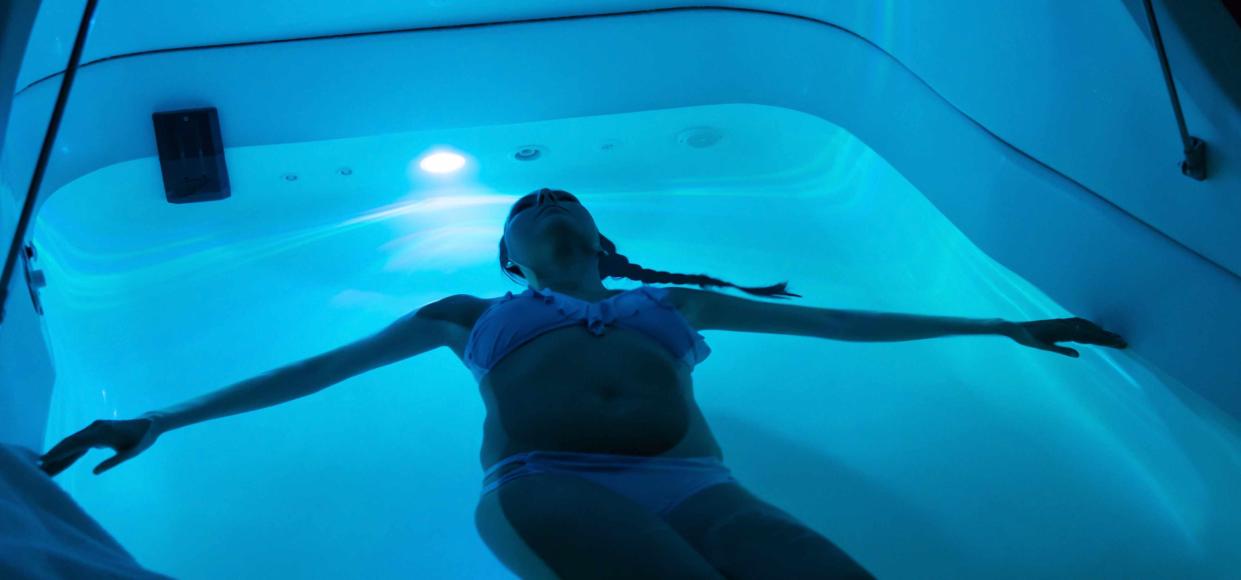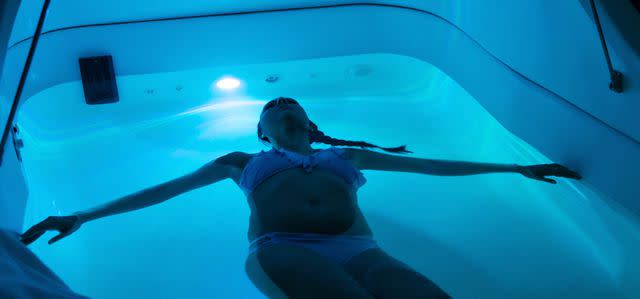Everything You Need to Know About Sensory Deprivation Tank Therapy

kali9 / Getty Images
Medically reviewed by Dakari Quimby, PhD
A sensory deprivation tank (also called a float tank, isolation tank, or flotation tank) is a soundproof, dark tank full of salt water. Sensory deprivation tank therapy, which also goes by many names, including float therapy and restricted environmental stimulation therapy (REST), involves spending time inside a float tank to reduce external stimuli.
Sensory deprivation tank therapy is advertised as offering health benefits, such as inducing deep relaxation, managing anxiety and pain, improving sleep, and boosting heart health. However, the research is limited and public information about float tanks may not always be backed by published scientific studies.
This article describes how sensory deprivation therapy works and the potential benefits and risks.

kali9 / Getty Images
What Is a Sensory Deprivation Tank?
The sensory deprivation tank was first developed by John C. Lilly, a neuroscientist interested in studying human consciousness, in the 1950s. He believed he could get better insight into how the brain works by cutting the mind off from external stimuli. He also wanted to counter existing theories that the brain “needed” outside stimulation to function.
Realizing that being submerged in water can effectively cut a person off from other stimulation, Lilly developed a tank filled with salt water that allowed a person to float, keeping their face above the water.
Initially, these tanks were closed, cutting a person off from any external light or sound. Now they can be adjusted to allow in some light, be left open, or even play relaxing music, depending on your preference. They are filled with 10 inches of body-temperature water mixed with Epsom salts (magnesium sulfate).
Typical sensory deprivation tank therapy sessions last about 60 minutes, though they can be shorter or longer. You lie on your back and float without the sensation of gravity, temperature, sound (if you opt for no music), or visual stimuli while focusing on breathing. Generally, the experience is described as pleasant and relaxing.
Health Benefits Behind Sensory Deprivation
Since its inception, sensory deprivation tank therapy has become a mainstay of complementary and alternative medicine (CAM), which includes massage, acupuncture, and other therapies. Some research has found psychological and health benefits associated with this therapy, though additional research is needed to back these claims.
Increased Creativity
Sensory deprivation tank therapy is thought to boost creativity by allowing you to easily access your creative mind without external stimulation. While the claim is broad and hard to prove, sensory deprivation has been shown to slow down secondary thought processes (things like abstract thinking or thoughts about everyday life), allowing room for primary processes, such as intuition, imagination, or a focus on the immediate moment.
Improved Concentration and Focus
Another publicized benefit of sensory deprivation tank therapy is that sessions can improve concentration and focus. This is explained by the introspection associated with the experience. The absence of distractions may allow you to sharpen your thinking and enhance goal orientation. Initial studies have noted these qualities as part of why this therapy can be helpful alongside psychotherapy.
Boost in Physical Performance
Sports and athletics aren’t just a pursuit of the body; competition and physical achievement also involve developing the right mindset. Initial evidence has supported claims that sensory deprivation tank therapy may help with recovery from intense physical workouts. Research has found sessions to help with physical recovery and the psychological stress and strain of competition.
Treats Anxiety
Preliminary research has found that sensory deprivation tank therapy may be useful for people with anxiety. A study from 2018 of 31 people with high anxiety sensitivity (meaning they quickly became anxious and perceived it as very harmful) found 90-minute floatation sessions to have a distinct antianxiety (anxiolytic) effect. This was measured through patient self-reports and physical measures, such as lower levels of stress hormones.
However, there are many well-established approaches to treating anxiety such as therapy and medication. Float therapy may be useful alongside these approaches, but there is not enough scientific evidence for float therapy as a primary treatment option.
Relieves Pain
Pain relief is another claimed benefit of sensory deprivation tank therapy. Though some studies have found sessions raise endorphins (stress- and pain-relieving hormones), others lack evidence to support this claim. According to an analysis from 2014, the evidence regarding hormone levels was somewhat unclear, though patients generally reported feeling less pain after treatment.
Improves Cardiovascular Health
Likely due to the feelings of relaxation and calm associated with sensory deprivation, some research has found this therapy to help with the health of the heart and blood vessels. In turn, those who’ve had treatment may also have healthier breathing. As such, this therapy—when used with others—may help improve cardiovascular health.
Can Sensory Deprivation Tank Therapy Cure Diseases?
While there is evidence that sensory deprivation may help with certain health conditions, this therapy alone isn’t curative and should not replace standard treatments.
Increased Feelings of Happiness
Because of its effects on anxiety and depression, there’s considerable evidence that sensory deprivation tank therapy can boost your overall sense of happiness. A study of 50 people with anxiety and depression found reductions in negative affect (negative emotions and poor self-concept) following a one-hour session.
This finding supports other studies that identified increased self-reported optimism following treatment.
Better Sleep
Another common claim about sensory deprivation tank therapy that stands up to scrutiny is that it promotes better sleep. A wide-ranging review noted several studies that found positive effects on sleep quality and insomnia (an inability to fall or stay asleep). Another study found improved sleep, linking the development to reduced stress levels.
Sensory Deprivation as Preventative Therapy
A randomized controlled trial of individuals using sensory deprivation tank therapy found that it may help prevent certain conditions. Primarily linked to reductions in stress levels, these include:
Depression: Scores for depression were significantly lower among those who had sensory deprivation tank therapy. As such, treatment may help reduce the chances of developing these issues.
Anxiety: As with depression, there were also significant reductions in anxiety levels. Float therapy may help protect against anxiety disorder and associated panic attacks.
Sleep problems: Insufficient or poor sleep is associated with an increased risk of hypertension (high blood pressure), heart disease, and obesity, among other conditions. Sensory deprivation tank therapy improved sleep, thus helping prevent these conditions.
Pain: Among the noted effects of sensory deprivation therapy is pain reduction. The study confirmed that treatment reduced the perception of joint and muscular aches.
What Are the Negative Effects of Sensory Deprivation?
As with any therapy, sensory deprivation carries risks and may cause harmful effects. Consider the potential adverse effects before your first float therapy session.
Hallucinations
The profound effects of sensory deprivation can cause some people to experience hallucinations (seeing or hearing things that aren’t there). In one study, there were isolated reports of visual hallucinations, typically arising as colors or shapes. Others experienced “out of body” experiences, which were not always considered unpleasant. Nonetheless, some people may find these experiences disturbing should they arise.
Drowning
There is always a risk of drowning since float therapy involves water, although this is rare. Nowadays, there are safeguards in place in most places that offer sensory deprivation tank therapy, such as intercom systems that allow participants to raise the alarm if they become frightened or uncomfortable.
Pain and Discomfort
Another potential adverse effect of sensory deprivation tank therapy is pain or discomfort on the skin caused by exposure to Epsom salts. Pain should only arise if you have a cut or injury on your skin.
What Happens When You Arrive at a Floatation Center?
When you arrive at a floatation therapy center, a staff member will give you a brief orientation. They’ll show you the pod you will use, how to open and close the door, and other vital pieces of information.
Sessions typically last about an hour, though you should budget extra time for changing and showering before and after. Once you’ve completed the orientation, here’s what you can expect:
Shower: Similar to going to a public pool, you’ll be asked to shower with shampoo and bodywash before beginning.
Float: Once you have showered, you will enter the float tank either wearing a bathing suit or being nude, whichever you find more comfortable. You can opt to keep the pod open or closed. Some float therapy locations also offer gentle music.
Rinse: After your session, you’ll likely want another shower to rinse the salt water off your body.
You can expect to feel the relaxing effects of the therapy for up to 24 hours afterward. Some research has reported that some people find it more relaxing than massage or acupuncture. The cost per treatment will vary based on location. In general, you can expect to pay between $30 and $70 per hour.
Menstruation and Floatation Therapy
It is safe to do float therapy while on your period, as long as you wear a tampon or menstrual cup. If you bleed heavily and need to replace period products more than once per hour, consider rescheduling your appointment.
Determining If Float Therapy Is Right for You
While there are many benefits of float therapy, this treatment isn’t for everyone. It is safe for most adults, even those who are pregnant. Float therapy is not recommended if you have the following:
Open wounds or scrapes on your skin
Skin conditions, such as eczema or psoriasis
An infectious disease, such as the common cold or flu
Epilepsy or other disorders that cause seizures
Claustrophobia (a fear of enclosed or tight spaces)
Intoxication due to alcohol or drugs
Summary
Sensory deprivation tank therapy, commonly known as float therapy, involves floating in a tank or pod filled with salt water. To reduce external sensory stimuli, sessions help you relax and focus on yourself. Preliminary research suggests that float therapy may be useful for reducing stress, easing anxiety, helping with pains and aches, and improving sleep, among other benefits.
Though float therapy is safe for most people, it should not be used as a primary treatment option, since there is limited research to support its efficacy.

